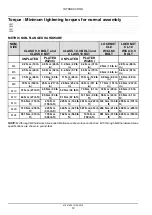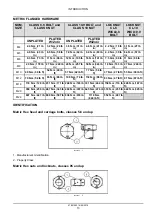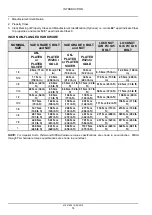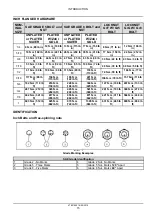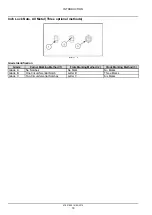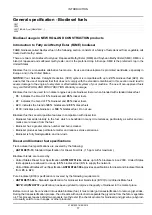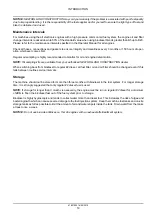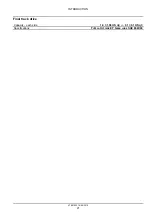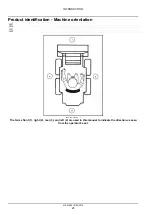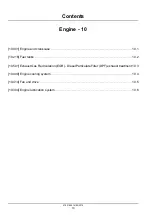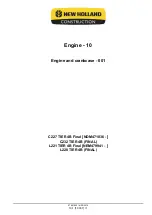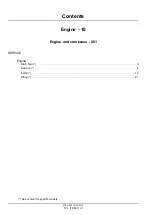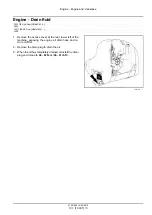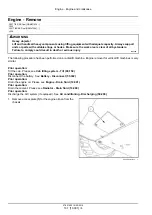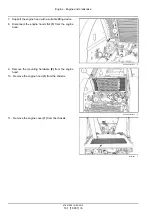
INTRODUCTION
General specification - Biodiesel fuels
C227
C232
L221 TIER 4B Final [NEM479941 - ]
L228
Biodiesel usage in NEW HOLLAND CONSTRUCTION products
Introduction to Fatty Acid Methyl Ester (FAME) biodiesel
FAME biodiesel, called biodiesel fuel in the following section, consists of a family of fuels derived from vegetable oils
treated with methyl esters.
There are two main biodiesel fuel types: Rapeseed Methyl Ester (RME) and Soybean Methyl Ester (SME). RME is a
blend of rapeseed and sunflower methyl ester, and is the preferred crop in Europe. SME is the preferred crop in the
United States.
Biodiesel fuel is a renewable alternative fuel source. Its use and development is promoted worldwide, especially in
Europe and in the United States.
NOTICE:
Your Selective Catalytic Reduction (SCR) system is compatible with up to
20 %
biodiesel fuel (B20). Be
aware that the use of biodiesel fuel that does not comply with the standards mentioned in this section could lead to
severe damage to the engine, fuel system or aftertreatment system of your machine. The use of non-approved fuels
may void NEW HOLLAND CONSTRUCTION Warranty coverage.
Biodiesel fuel can be used to run diesel engines as pure biodiesel fuel or when blended with standard diesel fuel:
• B5: indicates the blend of
5 %
biodiesel and
95 %
diesel fuels.
• B7: indicates the blend of
7 %
biodiesel and
93 %
diesel fuels.
• B20: indicates the blend of
20 %
biodiesel and
80 %
diesel fuels.
• B100: indicates pure biodiesel, or
100 %
biodiesel fuel. Do not use.
Biodiesel fuel has several positive features in comparison with diesel fuel:
• Biodiesel fuel adds lubricity to the fuel, which is beneficial in many circumstances, particularly as sulfur and aro-
matics are removed from the fuel.
• Biodiesel has a greater cetane number and burns cleaner.
• Biodiesel produces less particulate matter and reduces smoke emissions.
• Biodiesel is fully biodegradable and non-toxic.
Diesel and biodiesel fuel specifications
Tier 4a diesel fuel specifications are covered by the following:
•
ASTM D975-10
, Standard Specification for Diesel Fuel Oils. (15 ppm sulfur maximum.)
Biodiesel blends are covered by:
• United States Diesel Fuel Specification
ASTM D6751-09
A
allows up to
5 %
biodiesel since 2009. United States
fuel suppliers are allowed to use up to
5 %
biodiesel fuel (B5) to supply the network.
• United States Biodiesel Fuel Specification
ASTM D7467-09
A
provides specifications for diesel and biodiesel blends
from B5 to B20.
Pure biodiesel (B100) specification is covered by the following requirements:
•
ASTM D6751-09
A
- Standard specification for biodiesel fuel blend stock (B100) for middle distillate fuels.
NOTE: ASTM D6751
specification has been updated to improve the quality of biodiesel in the market place.
Before raw oil can be converted into usable biodiesel fuel, it must undergo transesterification to remove glycerides.
During the transesterification process, the oil reacts with an alcohol to separate the glycerine from the fat or vegetable
oil. This process leaves behind two products: methyl ester (the chemical name for biodiesel) and glycerine (a byprod-
uct usually sold for use in soaps or other products).
47851950 14/05/2015
17
Summary of Contents for 200 Series
Page 6: ...47851950 14 05 2015 Find manuals at https best manuals com ...
Page 7: ...INTRODUCTION 47851950 14 05 2015 1 Find manuals at https best manuals com ...
Page 12: ...INTRODUCTION Safety rules C227 NA C232 NA L221 NA L228 BT09A213 1 47851950 14 05 2015 6 ...
Page 51: ...This as a preview PDF file from best manuals com Download full PDF manual at best manuals com ...










